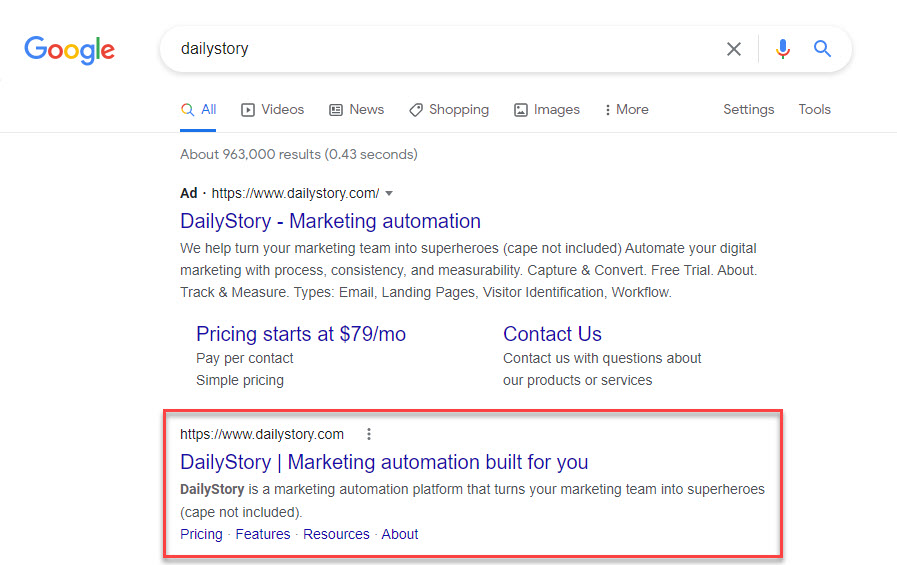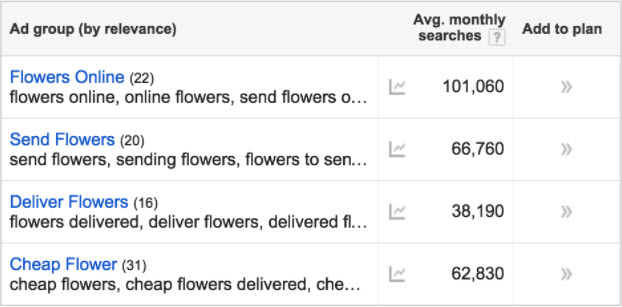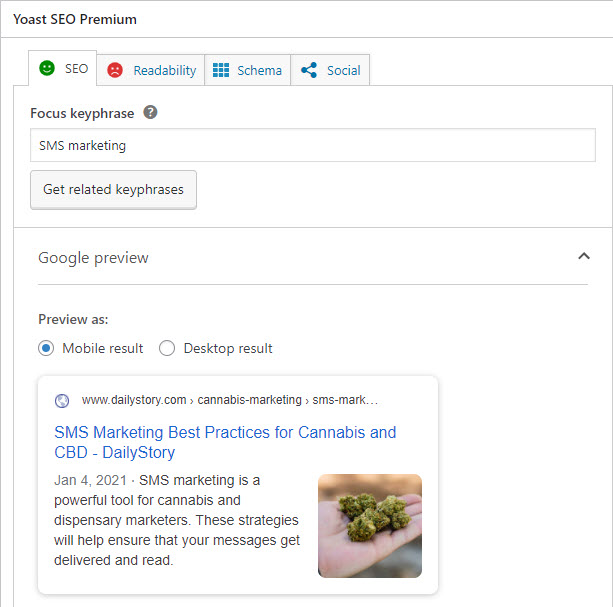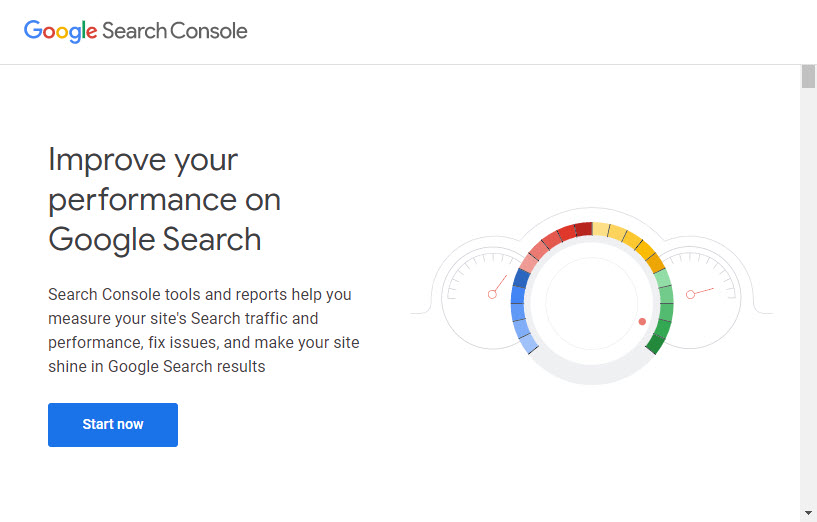Dispensary Search Engine Optimization (SEO) is the culmination of all the efforts you make to boost the ranking of your dispensary website in search engine results pages (SERPs). This includes search engines such as Google, Bing, and Yahoo. But, focusing on Google is your first priority.
Great SEO rank for your cannabis business or dispensary creates awareness about your locations, products, and offerings. And, most importantly, makes it easier for customers to find you.
Where is your dispensary in the search engine results page?
The most important question you should think through is, “how do people find me?”
Start by using Google and Google maps. This is where most people will start when they are looking for a dispensary or product. Search for your business name and your competition.
Below are some example Google searches to find cannabis dispensaries near you.
Example Google searches for your dispensary
This isn’t a complete list of possible Google searches, but good examples of where to start.
- Dispensary [city name]
- Medical cannabis dispensary
- Dispensary near me
- Medical marijuana dispensary
- Name of dispensary
- Recreational marijuana dispensary [city name]
Review the results shown on Search Engine Results Page (SERP)
The results of your search, such as “cannabis dispensary near me”, is shown on the Search Engine Results Page (SERP). Where your dispensary shows up in the SERP directly impacts your customers’ ability to find you.
Target the first page of the search results
The ideal position is the first result on the first SERP.
For example, a search for “DailyStory” shows a pay-per-click (PPC) ad first and then the organic search results:

The “dailystory” keyword on the search engine results page returns the expected result: DailyStory | Marketing automation built for you on the first page of the first result on the SERP.
Rank for your organic keywords
Ranking is where your results show on the search engine result page for your dispensary keywords. Your goal is to “rank” on the first page for your most important keywords, such as your dispensary’s name.
For example, if your unique dispensary name isn’t first. That’s a problem – and you can’t run paid search on Google. But similarly, trying to rank for “marijuana dispensary” by itself will be very difficult.
If your unique dispensary name is not showing up on the first page, you need to spend some time on your website’s search engine optimization and your Google My Business page.
Unfortunately most dispensary owners don’t understand the power of Search Engine Optimization (SEO) or the value of Google My Business. But good SEO is one of the pillars of a great cannabis dispensary digital marketing strategy. And, it’s worth the time and money.
Good SEO increases the amount of free traffic you generate to your website.
Below are some tips and recommendations. For a more comprehensive guide to SEO we recommend this article on What is SEO?
Optimize your dispensary website for search
Search engine optimization is everything you do on your website to optimize how search engines rank your content. And, while there are lots of tricks for squeezing the last bit of Google SEO juice out of a page such as republishing old articles, you should focus on the SEO fundamentals first.
Focusing on the SEO fundamentals starts with defining an organic search keyword list.
Define an organic search keyword list
An organic search keyword list is a list of words and phrases people use when they search for your dispensary.
Paid search, or pay-per-click (PPC), is paying the search engine to show ads when people search for those keywords or phrases. Dispensaries, cannabis, and CBD products have very limited options for using PPC. We recommend focusing your efforts on organic search first.
To begin with, list the keywords that people will use when searching for your products and services. Write out a list in Google Sheets or Excel – as you’ll want to keep track of it.
Example dispensary SEO keywords
Good examples of dispensary keywords may include:
- Your dispensary name
- Dispensary + [city]
- Dispensary + [neighborhood]
- Recreational cannabis
- Product brands
- Where can I find flower new me
- Where to buy cannabis near me
- and variations using Kush, marijuana, and vape
These are all common keywords and phrases potential customers might use. And they will likely use variations related to your location. So be creative when thinking through your keywords!
Optimize for long-tail keywords for visitor intent
Optimizing your dispensary website for long-tail keywords is a good strategy to align content with search intent.
What is a long-tail keyword? A long-tail keyword is a very specific phrase vs. an individual keyword. For example, “edible” is an example of a keyword. “Buy sativa edibles in boulder Colorado” is an example of a long-tail keyword.
A long-tail keyword will not have the same search volume as a specific keyword, but the long-tail keyword has very specific intent for what the search was for.
Tools for tracking dispensary keywords and rank
We recommend using commercial tools to help with your SEO. We like SEMRush, but you may also want to look at Moz and Ahrefs. These tools can help you analyze your website and competitor’s dispensary websites for keywords and their ranking in SERPs. And, you use them to monitor your keywords and your ranking in the SERPs.
An alternative to the commercial tools, is Google’s Keyword Planner.
Google’s Keyword Planner is part of Google Ads. Keyword Planner was built to help you pick the right keywords for paid search (PPC). But you can also use it to identify keywords for your organic search too.
Google Keyword Planner will tell you the average monthly searches for a given keyword as well as provide related keywords:

Now that you’ve identified the best keyword used to help people find your dispensary, it’s time to use those keywords and phrases through-out your website.
Write great content using your dispensary short and long-tail keywords
“Content is King” and the Internet was built to help people easily access the content they need, such as finding your dispensary!
This means that in addition to basic content about your store and location, you should write content for your website that incorporates the keywords you want people to search for.
One of the easiest ways to do this is using a blog.
Start a blog focused on cannabis or CBD topics
Writing blog posts optimized for organic search is part of a content marketing strategy. Content marketing is beyond the scope of this article. But you can read more about content marketing here, but we’ll cover some basics.
People love helpful content. Some examples you can use as a cannabis marketer:
- Share your knowledge and passion for the cannabis industry
- Talk about new strains
- Discuss medical marijuana uses
- Review different cannabis or CBD products
- Create a April 20th guide for your city
- Answer common questions, such as: what are the benefits of different strains?
To get more ideas go to Quora or Reddit and search for cannabis related discussions. As an example, the r/weedbiz Subreddit is a great resource.

Use keyword repetition and variation
When writing content use keyword repetition and variation in page content – creating relevant page content is still the best way to rank high, and an important part of content creation is use of your keywords and phrases.
Never repeat keywords too often, but you should repeat keywords in your content 2-3 times for short pages and 4-6 times for longer pages.
Always include important keywords in your first paragraph. Location of the keyword or phrase helps the search engine know what the content is about.
If you use WordPress for your website, consider purchasing Yoast – there is a limited free version too. It’s an inexpensive plugin for WordPress that can help you author content focused on your keywords.

Use Standard HTML
When Google indexes your content it is looking through the web page examining the HTML markup to understand what the page is about.
It’s important to keep your content as simple as possible using standard HTML tags. Most important are header tags (<h1>, <h2>, <h3>, etc.).
Use dispensary SEO keywords in your section headers
Keywords should be included in the header tags to help Google and other search engines understand what the content is about.
For example, a bad header:
“We like this brand’s flower”
Versus a good SEO header:
“Ajoya Blue Dream is our favorite flower”
Each header should be no more than 70-90 characters.
Optimize page titles for dispensary SEO
Google considers the <title> HTML tag of your page to be another important SEO element of your page.
A great page title should be descriptive, concise and include several of the keywords targeted for the article. The closer the keywords are to the beginning of the title, the better.
Include your SEO keywords in the URL
Using keywords in your URL is important. The closer the keywords are to the domain, the better. For example, the URL for this article (excluding the domain):
/cannabis-marketing/dispensary-search-engine-optimization-guide
In this case /cannabis-marketing is a category of content. And the article is /dispensary-search-engine-optimization-guide.
Make sure you remove SEO stop words from your URL too.
Include dispensary keywords in the URL
The keywords for this article include “cannabis marketing”, “digital marketing”, “dispensary”, “dispensary owners” and more. So you can see how the URL includes important keywords related to the article.
The goal with your URL is again to help search engines understand what the content is about. Also, use hyphens to separate words.
Design for mobile to boost dispensary SEO
Cannabis marketers love SMS marketing. SMS marketing has a 95% open rate, because people are always on their mobile devices.
Google now uses your website’s ability to render on mobile devices as a ranking signal. And, if you aren’t optimizing your content for mobile devices you will lose search rank.
AMP enable your dispensary SEO
Google also introduced AMP (Accelerated Mobile Page) as a way to write mobile optimized content so that it would load faster. And, adding AMP support for your website when using WordPress is as simple as adding a plugin.
Secure content (HTTPS) is a must for dispensary search engine optimization
Google also has indicated that content served securely will receive a search boost. Implying that content not served securely (using SSL/HTTPS) will lose search rank.
If your dispensary’s website or CBD product website is not using https:// for all of its website traffic, this should be fixed immediately. It’s both an easy problem to solve and one that has negative affects if it is not addressed.
Also, be sure that your website is set to only allow requests over HTTPS.
Great dispensary SEO requires content depth
Rather than write multiple pages for a given keyword or phrase it is best to create a single in-depth article. Otherwise you may find yourself competing with your own content to rank for a particular keyword or phrase.
If you have, in the past, created multiple articles that do compete consider folding them into a single article. Then use a 301 redirect – easy to setup with a tool like Yoast – and redirect traffic from the old article to the new article.
Sign-Up for Google Search Console and Google Analytics
These free tools will give you a comprehensive understanding of how your pages are performing and where you can make improvements.
Google Search Console will help you quickly identify problems with your site such as broken links or content that Google can’t index.

Google Analytics provides insights into your website traffic. Where visitors come from, what pages they read, where they bounce (exit), and more.
Advanced SEO techniques
Below are some advanced SEO techniques to look into after you’ve tackled the basics for your dispensary’s website.
Use Structured Data to describe your website
Structured data is information you add in your web pages to help search engines better understand your content. Structured data is essentially a vocabulary to describe your website to search engines. The vocabulary used is called Schema.org.
Once your dispensary’s SEO is on track, make sure and setup your dispensary’s Google My Business. It’s a critical part of your SEO strategy to help customers find you.
With this in mind you can further optimize your content with popups, also known as exit intent, to handle page bounces and still capture customer data.

